
How to Package Food for Sale: Essential Tips for Boosting Your Sales
This guide will walk you through everything you need to know about effectively packaging various types of food, whether you're dealing with canned goods, shelf-stable snacks, or frozen products.
BP Wholesale | August 03 2024If you're diving into the process of how to package food for sale, you've landed at the right spot. Packaging food items for the market involves more than just making them look appealing; it requires compliance with strict safety and quality standards to ensure your products make it from shelf to customer without a hitch.
We'll also touch on the importance of FDA-compliant labels and choosing the right packaging size and materials for your items.
Plus, for those looking to add a personal touch to their products, we'll cover the basics of branded labeling.
B&P Wholesale has been a food packaging wholesaler in the UK for 40 years. We’re here to share our knowledge and experience on how to package your food like a pro. If you have more questions or are in search of high-quality packaging solutions, don't hesitate to email us at info@bandpwholesale.co.uk. Check out our plethora of food packaging options from eco-friendly food storage containers to paper drinking cups to Kraft meal boxes and polythene bags.
Ready to learn more about packaging your food effectively? Let's get started.
Key Takeaways:
- Great packaging not only keeps your food fresh and delicious but also grabs customers' attention and helps build your brand.
- Choose the right packaging materials for your specific food products – it's about protection and presentation!
- Don't forget about FDA rules, clear labels, and being kind to the environment when picking your packaging.
Why Packaging Matters for Your Food Business
You might think of packaging as just a way to wrap up your food, but it's so much more than that. Good packaging does a few important things:
1. Keeps Your Food Fresh
Nobody wants stale cookies or soggy chips! The right packaging keeps your food safe from air, moisture, and those pesky little things that can spoil it.
2. Makes a Great First Impression
Nearly 90% of purchases are made after consumers scrutinize a product's packaging. Think of packaging as your food's outfit. If it looks good, people are more likely to want to try it.
3. Builds Your Brand
A unique and eye-catching design helps customers remember your products and come back for more.
Exploring The 3 Types of Food Packaging
It's important to understand the different levels of packaging involved in getting your food to the consumer:
1. Primary Packaging
This is what directly touches your product, like the candy wrapper, the chip bag, or the beverage bottle. It's crucial for keeping your food fresh and safe.
Example: Kraft box for food items
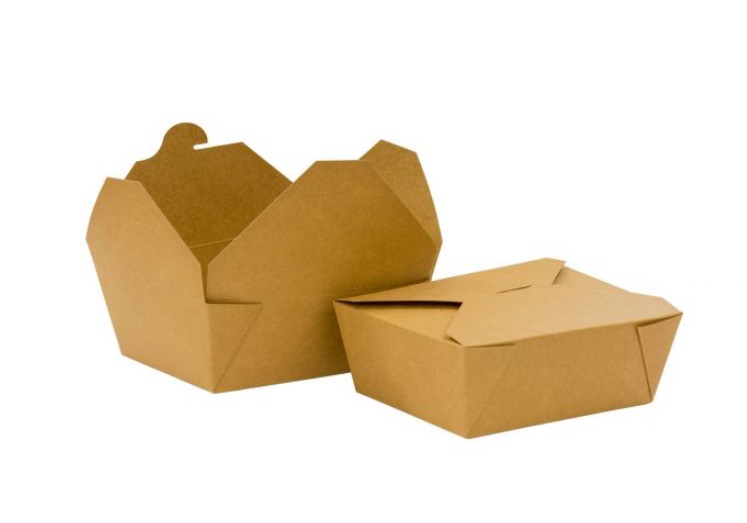
2. Secondary Packaging
This combines multiple primary packages together. Think of the cardboard box that holds a dozen granola bars or the plastic tray that holds several yogurt cups. It's what you see on store shelves.
3. Tertiary Packaging
This is used for shipping and handling large quantities of your product. You might never see it as a consumer, but it's important for getting your food from your kitchen to the stores safely.
Example: Tertiary packaging for bottled drinks includes transit packaging, such as the example we produced for Gilpins Gin shown below.
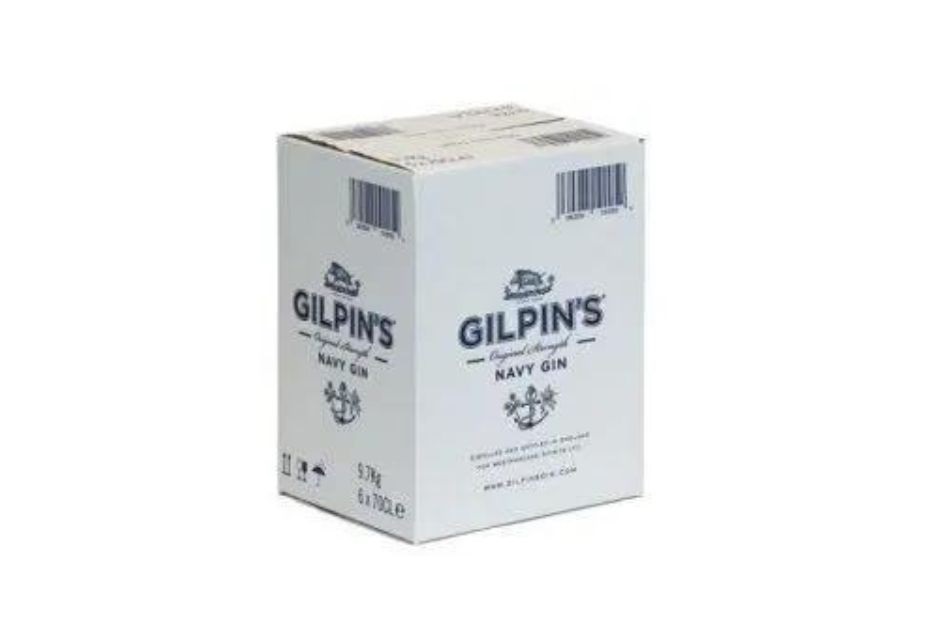
Types of Packaging Materials: The Lowdown
There is a multitude of options out there for packaging your food products. Each one brings its own set of advantages and disadvantages to the table. Making the right choice is critical to ensure your food remains fresh, safe, and enticing to customers. Here's a more in-depth look at some of the common choices, including eco-friendly alternatives, to help you make an informed decision:
1. Glass Jars
- Pros: Glass jars present an undeniable aesthetic appeal, lending an air of sophistication and quality to your product. They are reusable and recyclable, contributing to a circular economy. Being inert, glass doesn't interact with food, ensuring the flavor and integrity of your product remain intact. The option to heat-seal glass jars further extends the shelf life of your goods. Glass jars are especially suited for artisanal and premium products like jams, preserves, honey, and even gourmet salts.
- Cons: On the downside, glass is heavy, which can lead to increased shipping costs. Additionally, it is prone to breakage, making it less ideal for products that will be subjected to rough handling during transit. Lastly, glass jars tend to be more expensive than other packaging materials.
2. Plastic Containers
- Pros: Plastic containers boast lightweight construction, making them easy to handle and transport. Their versatility shines through in their range of shapes and sizes, catering to a broad spectrum of food products. Many plastic containers are now manufactured from recycled materials, aligning with sustainability efforts. Furthermore, they are often more budget-friendly than their glass counterparts. A significant benefit of plastic containers highlighted in a report by Trivium Packaging is their ability to reduce food waste by up to 50%, thanks to their protective and preservative qualities.
- Cons: While versatile, not all plastics are created equal. Some types may not be recyclable or reusable, posing an environmental challenge. There is also the concern of certain plastics leaching chemicals into food, especially when heated. It is imperative to choose food-grade plastics that are safe for use and, ideally, opt for recyclable or reusable options.
3. Cardboard Boxes
- Pros: Cardboard boxes stand out for their affordability and ease of customization, allowing your brand identity to shine through. They are readily recyclable and can even be manufactured from recycled materials, a bonus for eco-conscious businesses. Their sturdy structure provides good protection for a range of food products, especially baked goods and snacks. A study by Smithers Pira revealed that using recycled cardboard can significantly decrease greenhouse gas emissions by up to 73% compared to virgin cardboard.
- Cons: A notable limitation of cardboard boxes is their lack of moisture resistance. This makes them unsuitable for packaging liquids or foods with high moisture content unless a suitable liner or coating is used.
4. Pouches and Bags
- Pros: The flexibility and lightweight nature of pouches and bags make them a convenient option for many food products. They come in various materials like paper, plastic, and foil, each catering to specific needs. Heat-sealing further enhances their protective qualities. Pouches and bags are excellent for packaging items like granola, nuts, dried fruits, and other snackable goodies.
- Cons: Compared to rigid containers, pouches and bags offer less structural integrity, which might not be ideal for all types of food.
5. Bagasse Meal Boxes and Trays
- Pros: These boxes and trays, crafted from sugarcane pulp, are a sustainable alternative to conventional foam or plastic containers. Their compostable nature appeals to environmentally conscious consumers. Moreover, they are sturdy, microwaveable, and oil-resistant, offering a practical and eco-friendly packaging solution.
- Cons: Bagasse products might come with a slightly higher price tag than traditional options. Furthermore, they may not be as readily available as other materials.
6. Foil Containers and Lids
- Pros: Foil containers are a go-to for hot foods due to their oven-safe nature, keeping your culinary creations warm and ready to enjoy. Their recyclability (when clean) adds another eco-friendly dimension. They are commonly used for takeout and delivery services, ensuring your food reaches customers at the right temperature.
- Cons: Foil containers might not be the most sustainable option compared to others. They can also be somewhat flimsy and require careful handling to prevent spills or damage.
7. Styrofoam Trays with Plastic Covers
- Pros: These trays offer a combination of lightweight construction and affordability, making them suitable for short-term storage and transport of solid foods. The clear plastic covers add the benefit of product visibility.
- Cons: Styrofoam's limited recyclability makes it a less environmentally friendly choice. Moreover, it's unsuitable for liquids or long-term storage due to its potential to degrade over time.
8. Cellophane Bags
- Pros: Derived from plant-based materials, cellophane bags are compostable and offer good product visibility. Their versatility allows them to accommodate various food types.
- Cons: Compared to other materials, cellophane bags are not as robust and can be susceptible to tearing.
9. Polythene Bags and Liners
- Pros: Polythene bags are known for their strength and moisture resistance, making them reliable for protecting food products. They are available in various thicknesses (gauges) to cater to different needs.
- Cons: Their non-biodegradable nature contributes to plastic pollution, raising environmental concerns.
10. Vacuum Bags
- Pros: Vacuum bags are a champion when it comes to extending the shelf life of perishable foods. By removing oxygen, they create an environment that inhibits the growth of bacteria and mold.
- Cons: The use of vacuum bags necessitates specialized equipment, which can increase initial costs. The vacuum-sealing process may also distort the appearance of the packaged food.
11. Tin Cans
- Pros: Tin cans provide exceptional protection, shielding food from various external elements. They are ideal for long-term preservation and are often used for canned goods, soups, and beverages.
- Cons: Tin cans obscure the product from view, and their weight can add to shipping expenses. They also require specialized equipment for sealing, which can increase upfront costs.
Choosing the right packaging material is a balancing act. You need to consider factors like product type, shelf life, budget, branding, and environmental impact.
B&P Wholesale offers a full range of catering disposables and other supplies, so you can find everything you need to package and present your food in one place. Visit our website or give us a call to learn more about our products and how we can help your food business thrive.
Different Foods, Different Packaging Needs
The type of food you're selling will determine the kind of packaging you need. Let's break it down:
1. Hot Foods
Hot food packaging materials usually use heat-inductive materials and insulated boxes that keep the food hot.
Some examples include:
- Bagasse food containers - recommended for food items around -13°F to 428°F; can be used for storing hot/cold foods and reheating meals in the microwave
- Kraft Meal Boxes - the temperature limit is determined by the type of plastic lining the box.
- Aluminum containers - the temperature limits range from -20°F to 400°F; ideal for reheating prepacked entrees in the oven and are commonly used for packaging large quantities of food for takeout or catering events; Caterers prefer these containers for their convenience, as they can cook dishes in the oven and serve them directly from the same vessel.
- Microwavable containers - perform effectively in temperatures from 32°F to 257°F (0°C to 125°C). They are ideal for both heat-and-eat applications and deep-freeze storage.
Styrofoams - recommended for hot food items up to 175°F.
2. Soups
Soup packaging requires careful consideration to ensure both heat retention and leak prevention. Here are some popular choices:
- Plastic Containers with Lids: Ideal for both hot and cold soups, these containers are readily available and often microwave-safe for easy reheating. Look for options with airtight lids to prevent leaks during transport. Consider offering different sizes to cater to various serving preferences.
- Paper Soup Cups and Lids: These are perfect for takeaway soups and offer a cost-effective solution for small businesses.
- Bagasse Soup Containers: Sturdy, compostable, and microwave-safe for hot/cold soups. They are perfect for serving hot soups while showcasing your commitment to sustainability.
- Foil Containers with Lids: Similar to aluminum containers for hot foods, foil containers are oven-safe, making them a great choice for soups that require reheating. They also offer excellent heat retention for delivery and takeaway services.
- Glass Jars: Glass jars with airtight lids can be a stylish and reusable option for packaging cold soups or pre-made soup mixes. They are particularly popular for premium or artisanal soup brands.
3. Foods with Sauces
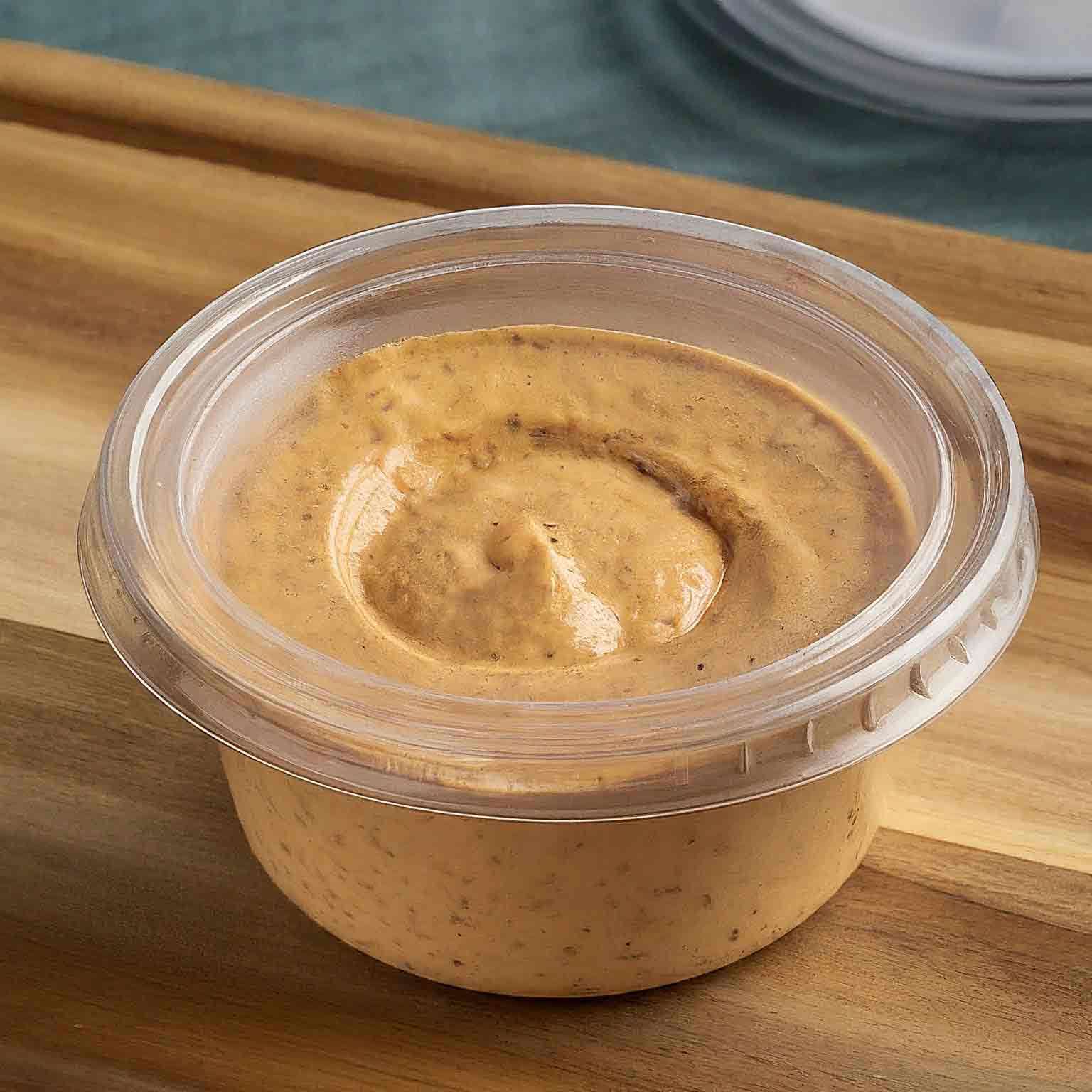
Packaging foods with sauces requires a balance between keeping the main item fresh and preventing the sauce from making it soggy. It's also about providing convenience and portion control for your customers.
Here's a breakdown of some suitable packaging options, considering the type of sauce and its intended use:
- Bottles: These are ideal for thicker sauces like ketchup, barbecue sauce, or dressings that need to be poured or drizzled. Glass or plastic bottles can be used, depending on your product and budget.
- Squeeze Bottles: Perfect for condiments like mayonnaise, mustard, or hot sauce that need to be dispensed easily and precisely. Squeeze bottles offer excellent portion control and are convenient for customers to use.
- Pouches: These are great for single-serve portions of sauce or for travel-sized options. Pouches are lightweight, flexible, and easy to store, making them popular for on-the-go meals or snack packs.
- Jars: Consider using jars for specialty or gourmet sauces that you want to showcase. Glass jars create a premium feel and allow customers to see the quality of your product.
- Cans: If your sauce has a longer shelf life, canning can be a great option. Cans are durable, protect against light and air, and can be easily stacked for storage and transport.
- Tubs: These are suitable for larger quantities of sauces or bulk packaging for food service businesses. Look for tubs with airtight lids to maintain freshness and prevent leaks.
- Sauce Pots: At B&P Wholesale, we offer a range of portion and deli pots in various sizes (1oz, 2oz, 4oz, 8oz, and 10oz), perfect for packaging individual servings of sauces, dips, or dressings. These pots come with secure lids to prevent leaks and ensure freshness.
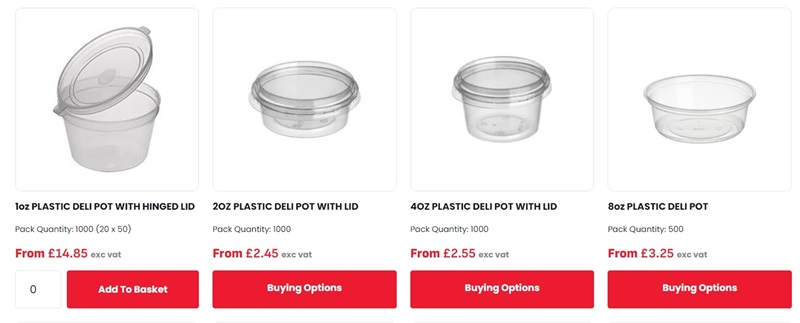
4. Shelf-Stable Snack Products
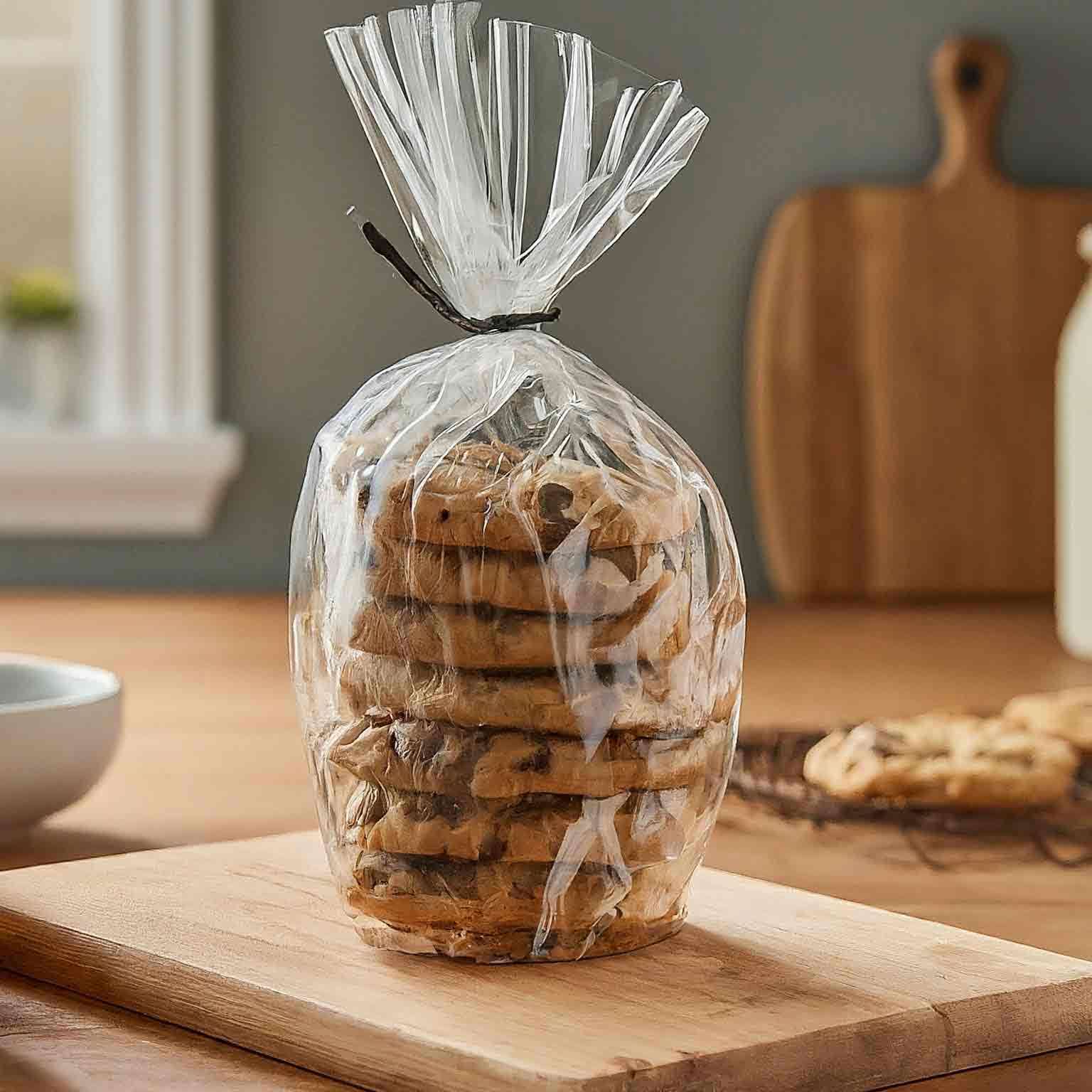 When it comes to packaging shelf-stable snacks like crackers, cookies, biscuits, granola bars, and nuts, maintaining freshness and crunch is paramount. Airtight packaging is key to preventing staleness and extending the shelf life of these treats.
When it comes to packaging shelf-stable snacks like crackers, cookies, biscuits, granola bars, and nuts, maintaining freshness and crunch is paramount. Airtight packaging is key to preventing staleness and extending the shelf life of these treats.
- Twist Ties and Zipper Bags: For small-scale businesses or products with a shorter shelf life, twist ties or resealable zipper bags can be a cost-effective option. They are easy to use and provide a decent level of protection against air and moisture.
- Vacuum Packing: Investing in vacuum packing equipment can significantly extend the shelf life of your snacks by removing oxygen from the packaging. This prevents oxidation and helps maintain the texture and flavor of your products for a longer period. Vacuum-packed snacks also take up less space, making them easier to store and ship.
- Individual Wrapping: If you're selling snacks in bulk or want to offer portion control, consider individual wrapping. This not only adds convenience for your customers but also helps maintain freshness as each snack is individually sealed. You can use flow wrap machines or hand-wrap each item depending on your production volume.
- Moisture Absorbers: Adding small packets of desiccant (moisture absorbers) to your packaging can further help to prevent spoilage, especially in humid environments. This is particularly important for snacks like crackers or cookies that are prone to becoming stale.
- Clear Packaging Windows: For added visual appeal, consider using packaging with clear windows that allow customers to see the delicious snacks inside. This can be particularly effective for showcasing unique shapes, colors, or textures.
- Polythene Bags: Polythene bags offer a versatile and cost-effective option for packaging snacks. They can be heat-sealed to create an airtight barrier, protecting your products from moisture and contaminants. B&P Wholesale offers a range of polythene bags in different gauges (thicknesses) to suit your needs. Choose from our 100 gauge, 120 gauge, and 200 gauge options for varying levels of durability and protection.
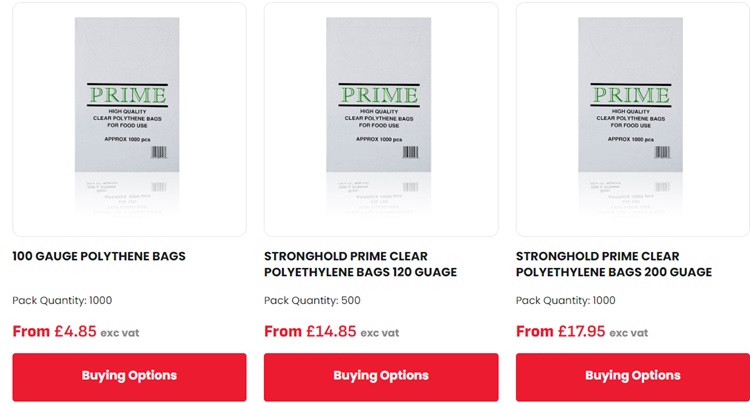
Polythene Bags from B&P Wholesale
5. Shelf-Stable Dried Goods
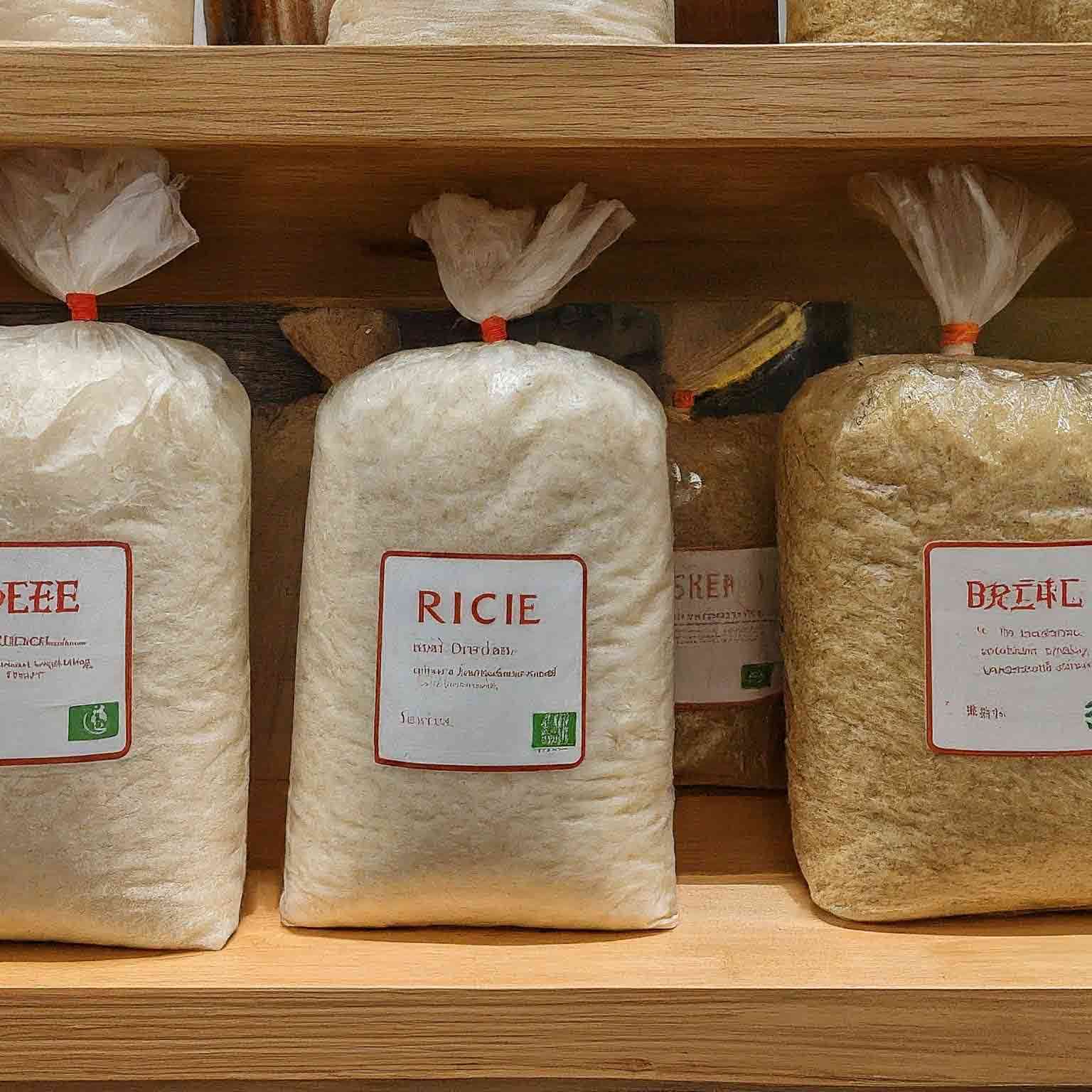
Think pasta, beans, and grains. You have more flexibility here but always label with a "best by" date so your customers know how long they'll stay fresh. Sturdy paper bags, cardboard boxes, or even resealable plastic bags can be used.
6. Refrigerated Products
These need to be sealed up tight to keep them from spoiling. If you're packaging hot foods like soup, make sure they're completely cooled before you seal them up to prevent condensation. Use airtight containers with secure lids. Consider using labels or stickers that change color to indicate if the product has reached an unsafe temperature.
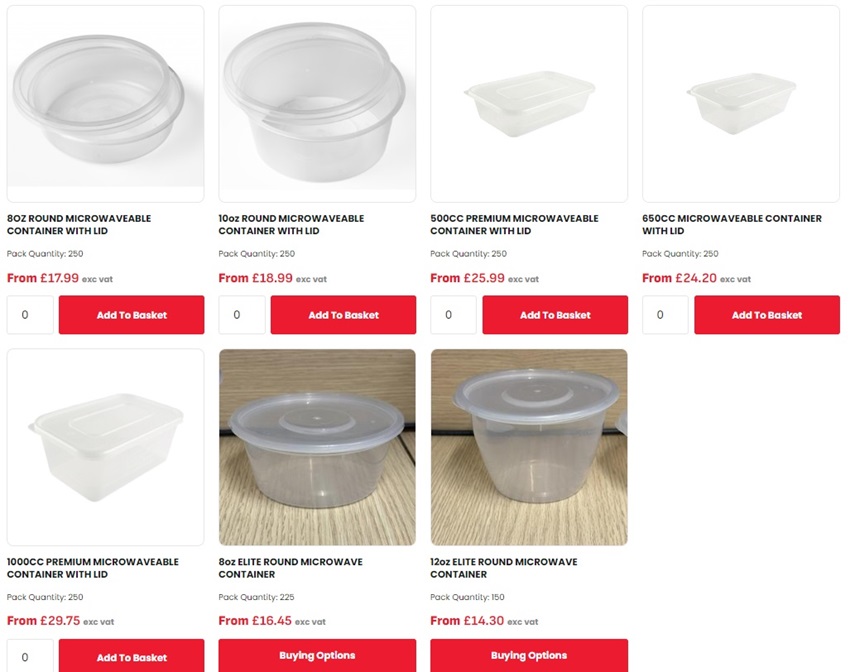 Microwavable Containers from B&P Wholesale
Microwavable Containers from B&P Wholesale
7. Frozen Products
Freezer burn is the enemy here! Freeze your products quickly and use packaging that can handle the cold temperatures. You might need thicker plastic bags than you'd use for shelf-stable items. Vacuum sealing can be a great way to prevent freezer burn and extend the life of your frozen products.
Consider the convenience of your packaging for consumers. Will they be able to easily open, close, and store the food? Can it be microwaved or oven-heated directly? Also, factor in the environmental impact of your packaging choices. Opt for materials that are recyclable, compostable, or made from renewable resources whenever possible to contribute to a sustainable future.
At B&P Wholesale, we understand the unique challenges of packaging frozen food. That's why we offer a range of solutions designed to keep your products safe and delicious, including:
Portion and Deli Pots for Frozen Foods: Our durable plastic pots are freezer-safe and come with secure lids to prevent leaks and freezer burn.
.jpg)
Foil Containers and Lids for Frozen Foods: These are ideal for packaging frozen meals that can be reheated in the oven.
.jpg)
Check out more here: https://www.bandpwholesale.co.uk/food-packaging/foil-containers-and-lids
Polythene Bags and Liners for Frozen Foods: Our heavy-duty polythene bags are perfect for bulk storage of frozen goods. We also offer blue-tinted box liners for added visibility and protection in the freezer.
Whether you're packaging ice cream, frozen meals, or other frozen treats, we have the right solution for you.
8. Pizza Packaging
Most pizza boxes are crafted from lightweight and cost-effective cardboard, with E flute corrugated cardboard being a popular choice due to its balance of thinness and strength.
The construction of these boxes is ingenious; they're typically designed with flaps that fold into the front wall, securely connecting at the edges to boost stability and insulation.
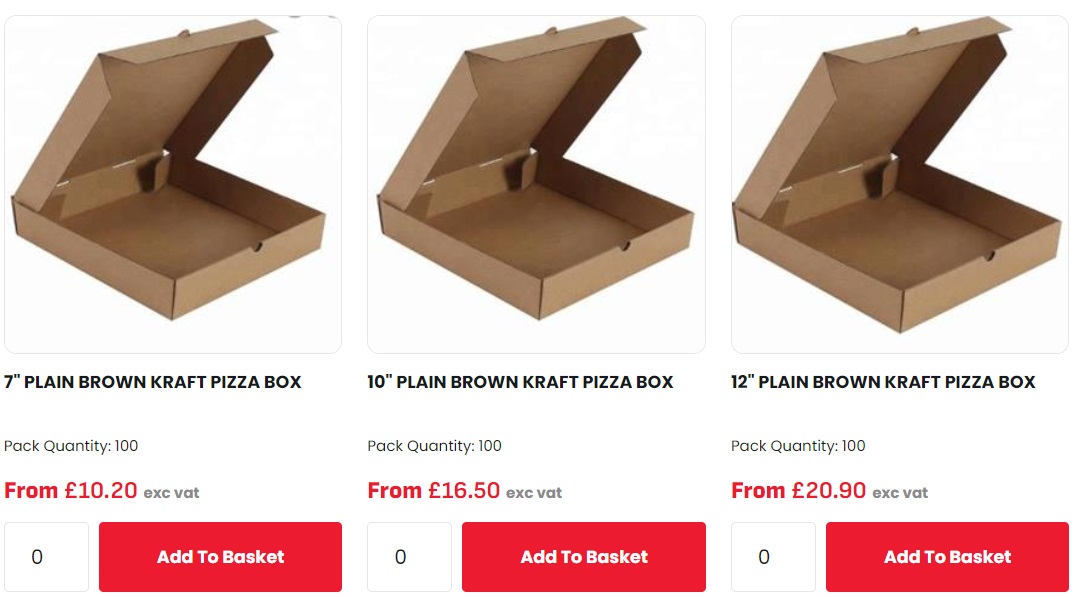
This design detail helps maintain an ideal internal environment, keeping the pizza warm while allowing just enough moisture to escape to keep the crust crisp. Inside, some boxes also feature a thin aluminum foil lining to prevent the oils from seeping into the cardboard, ensuring the pizza's flavor remains unaltered and the box doesn’t become soggy.
A Few More Tips for Packaging Success
- Tamper-Evident Seals: These let your customers know that their food is safe and hasn't been opened.
- Packaging Equipment: If you're getting serious about your food business, invest in some tools to make packaging easier and more efficient.
- Packaging Suppliers: Don't be afraid to ask for help! Many suppliers are happy to offer advice and guidance on the best packaging solutions for your business.
What Your Food Packaging Needs
Now, let's talk about the must-haves for any small food business, especially those in the UK selling products like gin:
1. UK Legal Compliance
In the UK, food packaging must adhere to strict regulations to ensure consumer safety and fair trading. The Food Standards Agency (FSA) is the governing body responsible for food safety and labeling. Make sure you are familiar with the following:
Food Information Regulation (FIR)
This regulation governs the labeling of food products in the UK. It outlines mandatory information that must be displayed on the label, including the name of the food, ingredients list, allergen information, nutrition declaration, and best before/use-by dates.
Spirit Drinks Regulations (SDR)
These regulations specifically address the labeling of alcoholic beverages, including gin. They require specific information like the alcoholic strength, bottle size, and specific warnings to be displayed prominently on the label.
- For more information, please refer to the following resources:
- Food Standards Agency (FSA)
- Food Information Regulations (FIR)
- Spirit Drinks Regulations (SDR)
2. The Right Size
Nobody likes a half-empty bag of chips. Make sure your packaging is the right size for your product to avoid waste and disappointed customers. This is especially important for spirits like gin, where standard bottle sizes (70cl, 1 liter, etc.) are expected by consumers.
3. Branded Labeling
This is your chance to shine! Design a label that's eye-catching and tells your brand's story. Use colors, fonts, and images that represent your business and appeal to your customers. For gin, consider using elegant typography, unique illustrations, or even embossing or debossing to create a premium feel.
In the UK, food and drink labeling is regulated by the Food Information Regulation (FIR) and, for alcoholic beverages like gin, the Spirit Drinks Regulations (SDR).
Here's what you need to include on your labels:
- Name of the Product: Make it clear and descriptive, so customers know what they're getting.
- List of Ingredients: Include all ingredients, in descending order by weight. Highlight any allergens (e.g., nuts, gluten) in bold.
- Allergen Information: If your product contains any of the 14 major allergens, they must be clearly emphasized within the ingredients list.
- Nutritional Information: This includes energy, fat, saturates, carbohydrate, sugars, protein, and salt per 100g/ml. You may also include additional nutrients voluntarily.
- Best Before/Use By Date: "Best before" indicates quality, while "use by" is for safety.
- Storage Instructions: Let customers know how to keep your product fresh.
- Name and Address of the Manufacturer/Importer: This is essential for traceability.
- Alcohol Content: For gin, this is a must. Make it clear and easy to read.
- Country of Origin: If relevant, especially for ingredients or alcoholic beverages.
Additionally, if you're selling gin, consider using the B&P Wholesale range of plain white labels or investing in a Klik price gun for easy pricing.
Remember, clear and accurate labeling is not only a legal requirement but also a key part of building trust with your customers. It shows that you're transparent about your products and care about their safety and satisfaction.
FAQs: Your Food Packaging Questions Answered
1. How can I start a food packaging business?
While this article focuses on choosing the right packaging for your existing food business, starting a food packaging business itself is a different venture. It involves understanding market demand, sourcing materials, investing in equipment, and complying with regulations. Consider researching the specific needs of your target market and partnering with reliable suppliers like B&P Wholesale to ensure you have access to high-quality packaging materials.
2. What is the typical food packaging process?
The food packaging process varies depending on the type of food and the chosen packaging materials. However, it generally involves the following steps:
- Preparing the food: This may include cooking, cooling, or portioning the food.
- Selecting the packaging: Choose the appropriate packaging materials based on the food type, shelf life requirements, and desired presentation.
- Filling and sealing: Fill the packaging with the food and seal it securely to maintain freshness and prevent contamination.
- Labeling: Apply labels that comply with all relevant regulations, including ingredients, nutritional information, and allergen warnings.
- Storage and transport: Store and transport the packaged food under appropriate conditions to maintain its quality and safety.
3. How can I prevent my cracker products from going stale?
Stale cracker products are a common concern for food businesses. To prevent this, choose packaging materials with good barrier properties against moisture and oxygen, such as airtight containers, vacuum bags, or polythene bags with heat sealing. Additionally, consider adding moisture absorbers (desiccants) to the packaging to further reduce the risk of staleness.
4. What are some tips for successful package selling?
Successful package selling involves more than just choosing the right materials. Here are some tips:
Create eye-catching designs: Your packaging should grab attention and stand out on store shelves.
Use clear labeling: Provide all necessary information clearly and concisely.
Consider portion control: Offer different package sizes to cater to various customer needs.
Focus on sustainability: Choose eco-friendly materials and minimize packaging waste whenever possible.
Tell your brand's story: Use your packaging to communicate your values and connect with your customers.
Wrapping Up
Packaging is a crucial aspect of any successful food business. It's not just about protecting your product; it's about presenting it in a way that's appealing, informative, and safe for your customers. By understanding the different types of food packaging, materials, and labeling requirements, you can make informed choices that will enhance your brand and boost your sales.
With careful planning and attention to detail, you can create packaging that not only protects your food but also tells your brand's story and leaves a lasting impression on your customers.
Happy packaging!
.jpg)